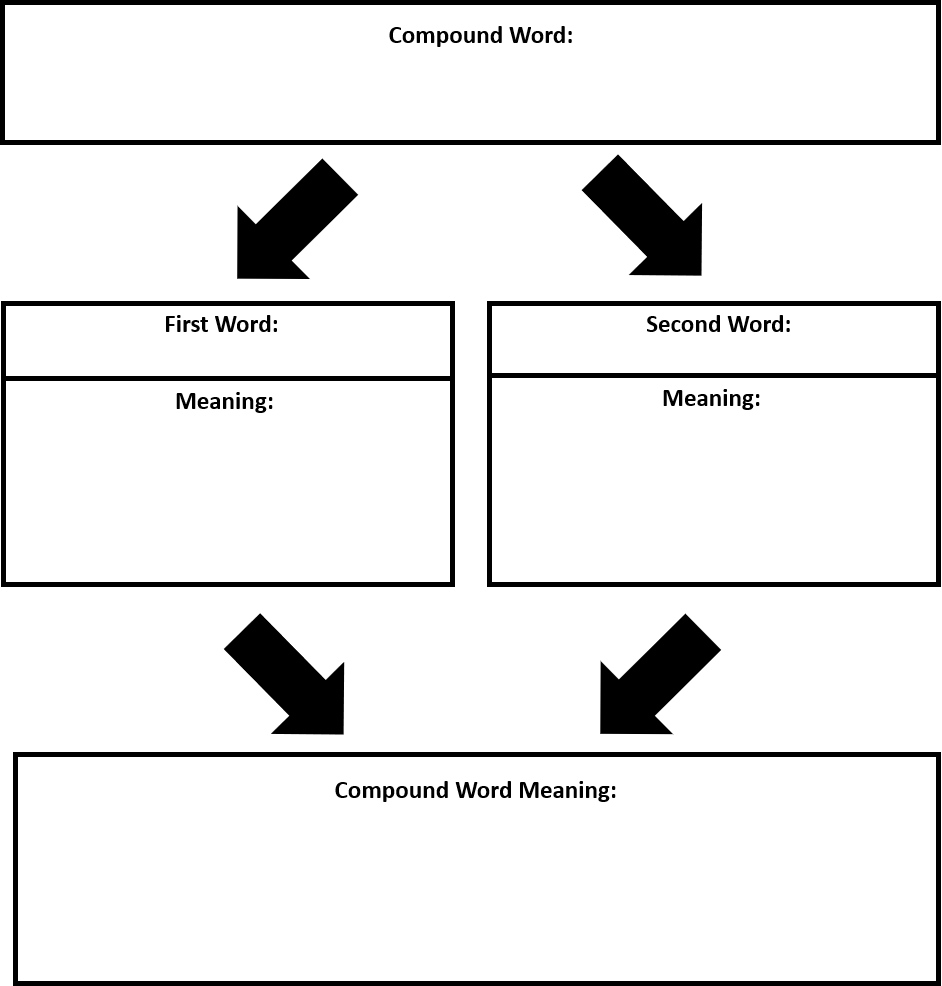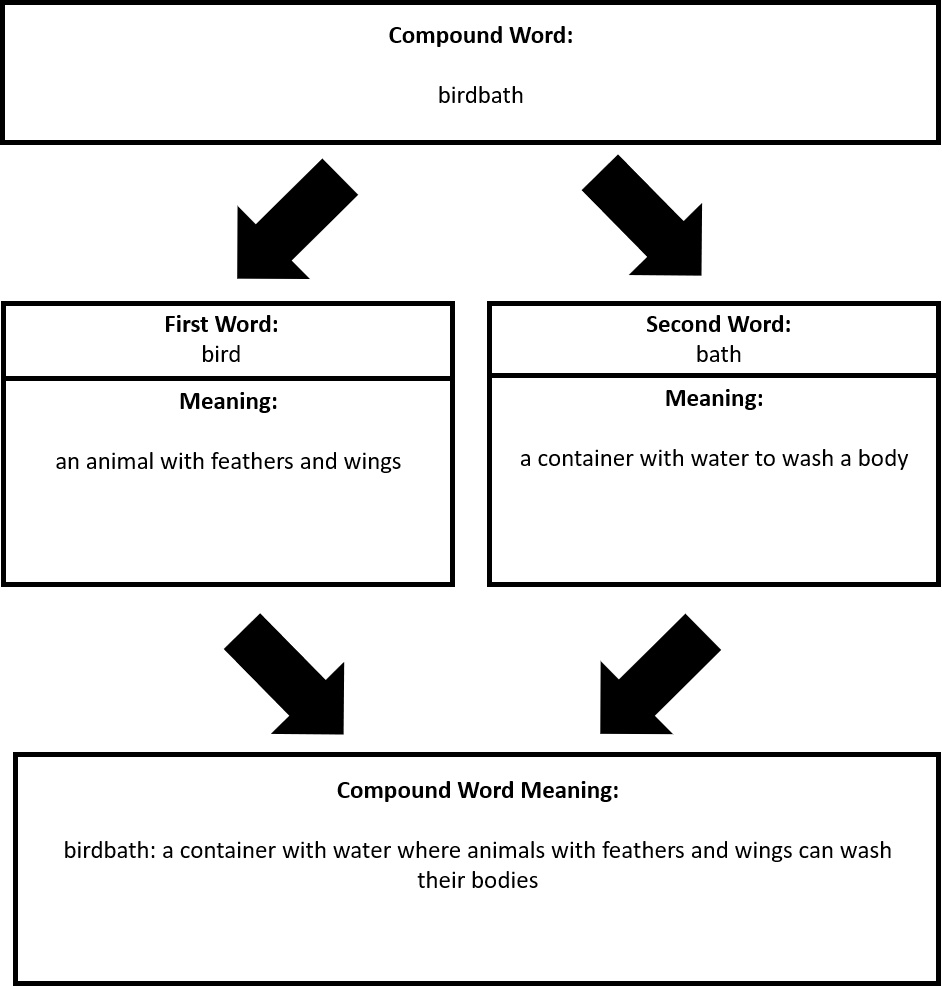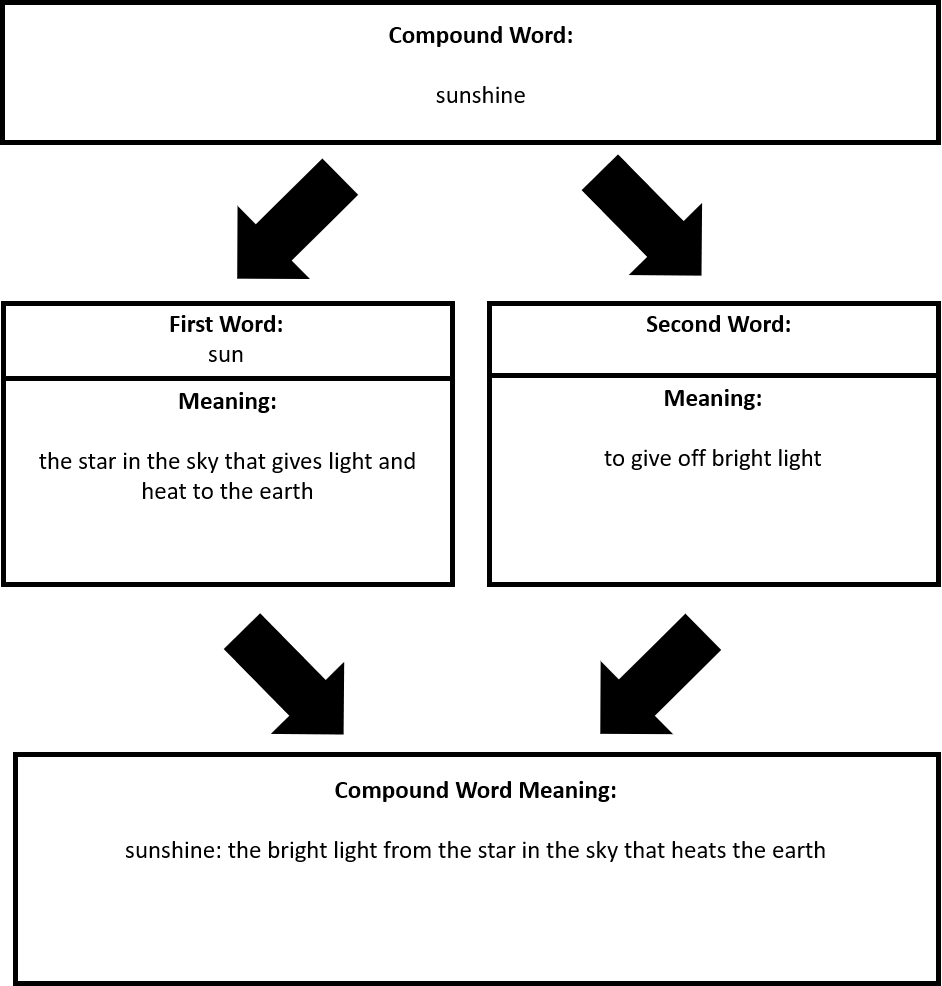Editor’s Note: This blog post is part of an ongoing series entitled “Effective Literacy Lessons.” In these posts, we provide a brief summary of the research basis for an approach to teaching reading or writing skills, and an example of how a teacher might “think aloud” to model what students should do in completing portions of the lesson. The intent of these posts is to provide teachers a starting point for designing their own effective literacy lessons.
Research Basis
Morphological knowledge, or the ability to identify and manipulate the smallest units of meaning within a word, contributes to students’ abilities to read and understand words as well as comprehend texts (Deacon, Francis, & Tong, 2017; Levesque, Kieffer, & Deacon, 2017). One approach to developing students’ morphological knowledge is by explicitly teaching them to identify and determine the meaning of compound words (Ramirez, Walton, & Roberts, 2013). Compound words are those that are formed by combining two or more words to create a new word, so examining the parts can support determining the overall meaning of the compound word.
Lesson Materials
For Teachers:
- Scripted purpose, introduction, and modeling
- Plan for guided and independent practice
- List of two-syllable compound words. Possible sources of compound words include the following:
- 1,000 examples of compound words from EnglishStudyHere
- 150 examples of compound words from TurtleDiary.com
- Compound Word Meaning Graphic Organizer (see Supplemental Resources for Teachers)
- If You Were a Compound Word (Shaskan, 2008)
For Students:
- Compound Word Meaning Graphic Organizer (see Supplemental Resources for Teachers)
- List of two-syllable compound words
Instructional Sequence
Lesson Appropriate for Second Grade
This is an introductory lesson that focuses on teaching students to read and understand compound words. This level of instruction is appropriate for students who have mastered reading and writing one-syllable words, including those formed with consonant blends (e.g., bl, dr, spl, tr), consonant digraphs (e.g., ch, ph, sh, th, wh), and vowel digraphs (e.g., ae, oa, ee, ie, ou).
1. Establish the Purpose
Teacher script: Being able to read and understand longer words is important to comprehending the books and other texts we read. When we come across a long, unfamiliar word, we can look for parts of the word that we already know to help us. Today, we are going to learn a strategy for reading and understanding compound words. This strategy will help you be a better reader who can figure out new compound words on your own when you see them in a text.
2. Introduce the Concept
Teacher script: A compound word is two or more single words combined to create a new word. Sometimes, we can figure out the meaning of the compound word by using what we know about the individual words that make up the compound word. Today, we will learn to use a graphic organizer to help us read and understand compound words.
3. Check for Understanding
Teacher script: What is a compound word?
Possible student responses include:
- A compound word is two or more single words combined to create a new word.
- Compound words can be broken apart into two words.
4. Introduce the Graphic Organizer
Project the Compound Word Meaning Graphic Organizer (see Figure 1 below and Supplemental Resources for Teachers) on the projection screen.
Figure 1. Compound Word Meaning Graphic Organizer

Teacher script: We will use this graphic organizer to break apart compound words so that we can read and define them. First, we will write the compound word in the box at the top that says “Compound Word.” Next, we will divide the compound word into its two parts. These parts should be words that you recognize. We will write the first part in the box that says “First Word” and the second part in the box that says “Second Word.” Below each word part, we will write the meaning of those words. In the last box at the bottom, we will rewrite the compound word and a definition of the compound word. We will use the definitions of the two word parts to help us come up with the definition of the compound word.
5. Model Using the Graphic Organizer
Project the following sentence: “The blue jay landed in the birdbath.”
Teacher script: I need to read this sentence. I know most of the words, but the one at the end is long and unfamiliar to me. “The blue jay landed in the…” To help me figure out the last word, I am going to start by looking for any words I already know. I know that compound words are when two or more words are put together to create a new word and meaning, so I am going to write this word in the first box on the graphic organizer.
Project the graphic organizer and write the word “birdbath” in the top box.
Teacher script: I can see two words I know in this compound word: “bird” and “bath.” In the box labeled “First Word,” I am going to write the word “bird” and the meaning of “bird” below that. For example, I could define this first word as “an animal with feathers and wings.”
Write the definition in the graphic organizer.
Teacher script: In the box labeled “Second Word,” I am going to write the word “bath” and its meaning below that. For example, I could define this second word as “a container with water to wash a body.”
Write the definition in the graphic organizer.
Teacher script: Because I can see two words that I know in this compound word, I can put the two words together to read the word: “birdbath.” Now that I can read the word, I am going to write it again in the bottom box of the graphic organizer. Next, I can use the definitions of the two words I already know to help me understand the meaning of the compound word. If I put the two definitions together, I could define “birdbath” as: a container with water where animals with feathers and wings can wash their bodies.”
Write the definition in the graphic organizer.
Teacher script: I am going to read the whole sentence: “The blue jay landed in the birdbath.” I want to check that I understand the sentence by explaining it with the meanings of the words. The blue jay has feathers and wings that allowed it to fly to the birdbath, so it is a type of bird. It landed in a container of water to wash its body.
Figure 2. Sample for Modeling Use of Compound Word Meaning Graphic Organizer

6. Guided Practice Using the Graphic Organizer
Distribute copies of the graphic organizer to students. Project the sentence: “The sunshine dried the blue jay’s wings.”
Teacher script: Here is another sentence in the same story. I bet you know most of the words in the sentence, but there is another long word. “The ________ dried the blue jay’s wings.” Let’s see if we can figure out the word by looking for parts we already know. First, let’s write the word in the box at the top of our graphic organizer.
Project the graphic organizer and write the word “sunshine” in the top box. Prompt students to write the compound word on their copies of the graphic organizer.
Teacher script: If this is a compound word, it will have words you already know in it. Tell me what two words you see.
Call on students and provide positive or corrective feedback as necessary.
Teacher script: In the box labeled “First Word,” write the first word “sun.” Then, turn to your elbow partner to discuss what this word means.
Write the word on the projected graphic organizer. After 1 minute, call on students to define “sun” and provide positive or corrective feedback as necessary.
Teacher script: Beneath the “First Word,” let’s write our definition: the star in the sky that gives light and heat to the earth.
Write the definition in the graphic organizer and have students write it as well.
Teacher script: In the box labeled “Second Word,” let’s write our second word, “shine.” Then, turn to your elbow partner to discuss the meaning of the second word.
Write the word on the projected graphic organizer. After 1 minute, call on students to define “shine” and provide positive or corrective feedback as necessary.
Teacher script: Beneath the “Second Word,” let’s write our definition: “to give off bright light.”
Write the definition on the projected graphic organizer and have students write it as well.
Teacher script: Because we know the two words in this compound word, we can put them together to read the new word: “sunshine.” Say it with me: “sunshine.” Say it one more time: “sunshine.” Now that we can read the word, let’s write it again in the bottom box of the graphic organizer.
Write the word on the projected graphic organizer and have students write it on their graphic organizers as well.
Teacher script: Next, we can use the definitions of the two words we already know to help us understand the meaning of the compound word. Turn to your partner and discuss how you might put the two definitions together to define our compound word “sunshine.”
After 1 minute, call on students to define “sunshine” and provide positive or corrective feedback as necessary.
Teacher script: Let’s write our definition of the compound word “sunshine” on our graphic organizer: “the bright light from the star in the sky that heats the earth.”
Write the definition in the graphic organizer and have students write it as well.
Teacher script: Let’s read the whole sentence: “The sunshine dried the blue jay’s wings.” We want to be sure we understand the sentence now, so turn to your partner and come up with a way to explain the sentence with the meanings of the words.
After 1 minute, ask students to explain the sentence with the meanings of the words.
Possible student responses include:
- The blue jay’s wings were probably wet from the birdbath. It used the bright light and heat from the sun to dry the water off its wings.
Figure 3. Sample for Guided Practice Using the Compound Word Meaning Graphic Organizer

Continue Defining Compound Words in Guided and Independent Practice
Provide students two or three more opportunities to complete the graphic organizer in partner groups by offering sample sentences containing compound words.
On a subsequent day, read aloud the storybook If You Were a Compound Word (Shaskan, 2008). During the read aloud, ask students to identify the compound words as they are encountered in the story. Write each compound word on the board for the students to see and ask them to determine the word parts before blending the parts to say the word. After the read aloud, ask students to work in pairs to define the compound words from the story using the graphic organizer. Students who demonstrate 90% or higher accuracy when defining new compound words using the graphic organizer are ready for independent practice identifying, reading, and defining compound words.
Concluding the Lesson
To conclude the lesson, review the concept of a compound word and why it is an important part of becoming a skilled reader. Ask students to describe the process of using the graphic organizer when reading and defining a compound word in a text. Eventually, students should be able to understand the meaning of compound words without using the graphic organizer. Plan to gradually remove this support by asking students to start completing portions orally and only using the organizer when a compound word is particularly difficult.
Supplemental Resources for Teachers
Compound Word Meaning Graphic Organizer
With this graphic organizer, children can identify and define the two words that were combined to make a compound word and use that information to define the compound word.
References
Deacon, S. H., Francis, K., & Tong, X. (2017). The relationship of morphological analysis and morphological decoding to reading comprehension. Journal of Research in Reading, 40, 1-16. doi:10.1111/1467-9817.12056
Levesque, K. C., Kieffer, M. J., & Deacon, S. H. (2017). Morphological awareness and reading comprehension: Examining mediating factors. Journal of Experimental Child Psychology, 160, 1-20. doi:10.1016/j.jecp.2017.02.015
Ramirez, G., Walton, P., & Roberts, W. (2013). Morphological awareness and vocabulary development among kindergarteners with different ability levels. Journal of Learning Disabilities, 47, 54-64. doi:10.1177/0022219413509970
Shaskan, T. S. (2008). If you were a compound word. C. C. Jones (Ed.). North Mankato, MN: Picture Window Books.
